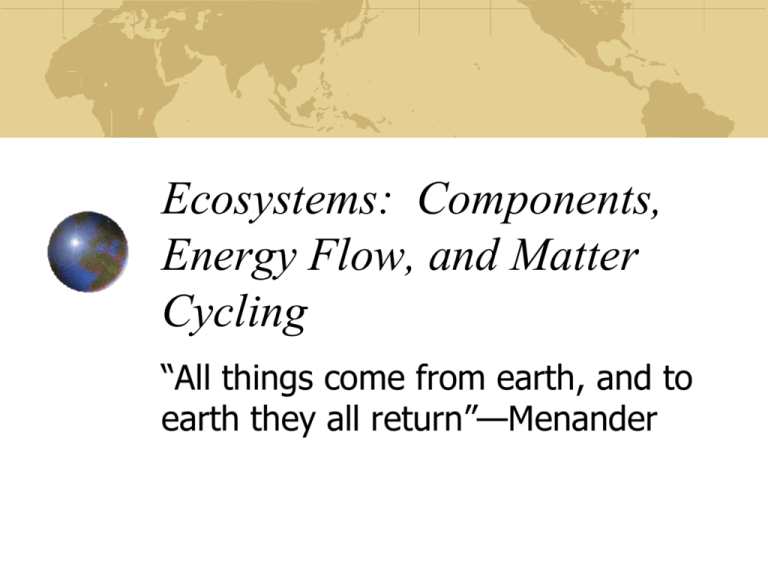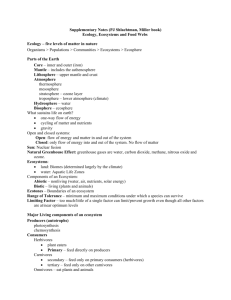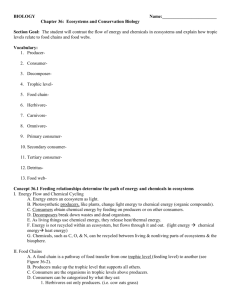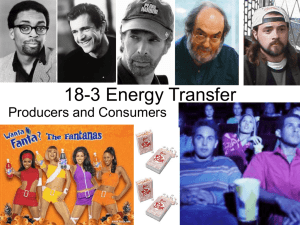Ecosystems: Components, Energy Flow, and Matter Cycling
advertisement

Ecosystems: Components, Energy Flow, and Matter Cycling “All things come from earth, and to earth they all return”—Menander Ecosystem Organization Organisms Biosphere Made of cells Eukaryotic vs Prokaryotic Species Groups of organisms that resemble one another in appearance, behavior, and genetic make up Sexual vs Asexual reproduction Production of viable offspring in nature 1.5 million named; 10-14 million likely Ecosystems Communities Populations Genetic diversity Communities Ecosystems Biosphere Populations Organisms Fig. 4.2, p. 66 Earth’s Life Support Systems Troposphere To 11 miles Air is here Atmosphere Biosphere Vegetation and animals Soil Stratosphere Crust Rock 11 to 30 miles Ozone layer Hydrosphere Solid, liquid, and gaseous water Lithosphere Crust and upper mantle Contains nonrenewable res. core Lithosphere Mantle Crust Crust (soil and rock) Biosphere (Living and dead organisms) Hydrosphere (water) Lithosphere (crust, top of upper mantle) Atmosphere (air) Sustaining Life on Earth… One way flow of high quality energy The cycling of matter (the earth is a closed system) Gravity Biosphere Carbon cycle Phosphorus Nitrogen cycle cycle Causes downward movement of matter Water cycle Heat in the environment Heat Heat Heat Oxygen cycle Major Ecosystem Components Abiotic Components Water, air, temperature, soil, light levels, precipitation, salinity Sets tolerance limits for populations and communities Some are limiting factors that structure the abundance of populations Biotic Components Producers, consumers, decomposers Plants, animals, bacteria/fungi Biotic interactions with biotic components include predation, competition, symbiosis, parasitism, commensalism etc. Limiting Factors on Land & in H2O Terrestrial Sunlight Temperature Precipitation Soil nutrients Fire frequency Wind Latitude Altitude Aquatic/Marine Light penetration • Water clarity Water currents Dissolved nutrient concentrations • Esp. N, P, Fe Dissolved Oxygen concentration Salinity The Source of High Quality Energy Energy of sun lights and warms the planet Supports PSN Powers the cycling of matter Drives climate and weather that distribute heat and H2O Solar radiation Energy in = Energy out Reflected by atmosphere (34%) Radiated by atmosphere as heat (66%) UV radiation Absorbed by ozone Lower Stratosphere Visible (ozone layer) Greenhouse light Troposphere effect Heat Absorbed by the earth Heat radiated by the earth Earth Fate of Solar Energy… Earth gets 1/billionth of sun’s output of energy 34% is reflected away by atmosphere 66% is absorbed by chemicals in atmosphere = re-radiated into space Visible light, Infrared radiation (heat), and a small amount of UV not absorbed by ozone reaches the atmosphere Energy warms troposphere and land Evaporates water and cycles it along with gravity Generates winds A tiny fraction is captured by photosynthesizing organisms Natural greenhouse effect vs. Global Warming Primary Productivity The conversion of light energy to chemical energy is called “gross primary production.” Plants use the energy captured in photosynthesis for maintenance and growth. The energy that is accumulated in plant biomass is called “net primary production.” Primary Productivity NPP=GPP-respiration rate GPP= RATE at which producers convert solar energy into chemical energy as biomass Rate at which producers use photosynthesis to fix inorganic carbon into the organic carbon of their tissues These producers must use some of the total biomass they produce for their own respiration NPP= Rate at which energy for use by consumers is stored in new biomass (available to consumers) Units Kcal/m2/yr or g/m2/yr How do you measure it? AP Lab Site Most productive vs. least productive What are the most productive Ecosystems? Estuaries Swamps and marshes Tropical rain forest Temperate forest Northern coniferous forest (taiga) Savanna Agricultural land Woodland and shrubland Temperate grassland Lakes and streams Continental shelf Open ocean Tundra (arctic and alpine) Desert scrub Extreme desert 800 1,600 2,400 3,200 4,000 4,800 5,600 6,400 7,200 Average net primary productivity (kcal/m2/yr) 8,000 8,800 9,600 Fate of Primary Productivity and Some important questions… Since producers are ultimate source of all food, why shouldn’t we just harvest the plants of the world’s marshes? Why don’t we clear cut tropical rainforests to grow crops for humans? Why not harvest primary producers of the world’s vast oceans? Vitousek et al: Humans now use, waste, or destroy about 27% of earth’s total potential NPP and 40% of the NPP of the planet’s terrestrial ecosystems Biotic Components of Ecosystems Producers (autotrophs) Source of all food Photosynthesis Heat Consumers=heterotroph Aerobic respiration Anaerobic respiration Methane, H2S Abiotic chemicals (carbon dioxide, oxygen, nitrogen, minerals) Heat Heat Decomposers (bacteria, fungus) Producers (plants) Decomposers Matter recyclers… Release organic compounds Heat into soil and water where they can be used by producers Consumers (herbivores, carnivores) Heat Solar energy Trophic Levels Each organism in an ecosystem is assigned to a feeding (or Trophic) level Primary Producers Primary Consumers (herbivores) Secondary Consumer (carnivores) Tertiary Consumers Omnivores Detritus feeders and scavengers Directly consume tiny fragments of dead stuff Decomposers Digest complex organic chemicals into inorganic nutrients that are used by producers Complete the cycle of matter Detritivores vs Decomposers stop Detritus feeders Bark beetle engraving Long-horned beetle holes Carpenter ant galleries Decomposers Termite and carpenter ant work Dry rot fungus Wood reduced to powder Time progression Mushroom Powder broken down by decomposers into plant nutrients in soil Fig. 4.15, p. 75 Energy Flow and Matter Cycling in Ecosystems… Food Chains vs. Food Webs KEY: There is little if no matter waste in natural ecosystems! First Trophic Level Producers (plants) Heat Second Trophic Level Third Trophic Level Fourth Trophic Level Primary consumers (herbivores) Secondary consumers (carnivores) Tertiary consumers (top carnivores) Heat Heat Heat Solar energy Heat Heat Detritvores (decomposers and detritus feeders) Heat Generalized Food Web of the Antarctic Humans Blue whale Sperm whale Killer whale Note: Arrows Go in direction Of energy flow… Elephant seal Crabeater seal Leopard seal Emperor penguin Adélie penguins Petrel Squid Fish Carnivorous plankton Herbivorous zooplankton Krill Fig. 4.18, p. 77 Phytoplankton Food Webs and the Laws of matter and energy Food chains/webs show how matter and energy move from one organism to another through an ecosystem Each trophic level contains a certain amount of biomass (dry weight of all organic matter) Chemical energy stored in biomass is transferred from one trophic level to the next With each trophic transfer, some usable energy is degraded and lost to the environment as low quality heat • Thus, only a small portion of what is eaten and digested is actually converted into an organisms’ bodily material or biomass (WHAT LAW ACCOUNTS FOR THIS?) Food Webs and the Laws of matter and energy Food chains/webs show how matter and energy move from one organism to another through an ecosystem Each trophic level contains a certain amount of biomass (dry weight of all organic matter) Chemical energy stored in biomass is transferred from one trophic level to the next With each trophic transfer, some usable energy is degraded and lost to the environment as low quality heat • Thus, only a small portion of what is eaten and digested is actually converted into an organisms’ bodily material or biomass (WHAT LAW ACCOUNTS FOR THIS?) Ecological Efficiency: The % of usable nrg transferred as biomass from one trophic level to the next (ranges from 5-20% in most ecosystems, use 10% as a rule of thumb) Thus, the more trophic levels or steps in a food chain, the greater the cumulative loss of useable energy… Food Webs and the Laws of matter and energy Ecological Efficiency: The % of usable energy transferred as biomass from one trophic level to the next (ranges from 5-20% in most ecosystems, use 10% as a rule of thumb) Thus, the more trophic levels or steps in a food chain, the greater the cumulative loss of useable energy… Pyramids of Energy and Matter Pyramid of Energy Flow Pyramid of Biomass Heat Tertiary consumers (human) Heat Decomposers Heat 10 Secondary consumers (perch) 100 1,000 10,000 Usable energy Available at Each tropic level (in kilocalories) Heat Primary consumers (zooplankton) Producers (phytoplankton) Heat Ecological Pyramids of Energy Ecological Pyramids of Biomass Implications of Pyramids…. Why could the earth support more people if the eat at lower trophic levels? Why are food chains and webs rarely more than four or five trophic levels? Why do marine food webs have greater ecological efficiency and therefore more trophic levels than terrestrial ones? Why are there so few top level carnivores? Why are these species usually the first to suffer when the the ecosystems that support them are disrupted? ATMOSPHERE LITHOSPHERE HYDROSPHERE ECOSPHERE Ecosystem Services and Sustainability Solar Capital Lessons From Nature! Water resources and purification Air resources and purification Soil formation and renewal Waste removal and detoxification Natural pest and disease control Climate control Natural Capital Biodiversity and gene pool Recycling vital chemicals Renewable energy resources Nonrenewable energy resources Nonrenewable mineral Potentially resources renewable matter resources 1. Use Renewable Solar Energy As Energy Source 2. Recycle the chemical nutrients needed for life Matter Cycles You are responsible for knowing the water, carbon, nitrogen, sulfur, and phosphorus cycles Know major sources and sinks Know major flows Know how human activities are disrupting these cycles BIOGEOCHEMICAL CYCLES ‘Fundamentals’ of biogeochemical cycles All matter cycles...it is neither created nor destroyed... As the Earth is essentially a closed system with respect to matter, we can say that all matter on Earth cycles . Biogeochemical cycles: the movement (or cycling) of matter through a system by matter we mean: elements (carbon, nitrogen, oxygen) or molecules (water) so the movement of matter (for example carbon) between these parts of the system is, practically speaking, a biogeochemical cycle The Cycling Elements: macronutrients : required in relatively large amounts "big six": carbon , hydrogen , oxygen , nitrogen , phosphorous sulfur HYDROLOGIC CYCLE CONNECTS ALL OF THE CYCLES AND SPHERES TOGETHER Water Quality Degradation IMPORTANCE OF CARBON CYCLE CARBON IS THE BACKBONE OF LIFE! Carbon Cycle MARINE CARBON CYCLE Diffusion between atmosphere and ocean Carbon dioxide dissolved in ocean water photosynthesis Combustion of fossil fuels aerobic respiration Marine food webs Producers, consumers, decomposers, detritivores incorporation death, sedimentation into sediments uplifting over geologic time sedimentation Marine sediments, including formations with fossil fuels Figure 4-29a Page 78 Slide 35 TERRESTRIAL CARBON CYCLE Atmosphere (most carbon is in carbon dioxide) Combustion of fossil fuels volcanic action photosynthesis Terrestrial rocks weathering combustion of wood (for aerobic clearing land; or for fuel respiration Land food webs producers, consumers, decomposers, detritivores Soil water (dissolved carbon) leaching runoff death, burial, compaction over geologic time sedimentation Peat, fossil fuels 14 CO2 emissions from fossil fuel (billion metric tons of carbon equivalent) 13 High projection 12 11 10 Low projection 9 8 7 6 5 4 3 2 1 0 1850 1900 1950 Year 2000 2030 Figure 4-30 Page 79 Slide 38 The Nitrogen Cycle Nitrogen is a key element for amino acids nucleic acids (purine, pyrimidine) cell wall components of bacteria (NAM). Nitrogen Cycle IMPORTANCE OF PHOSPHOROUS CYCLE 1.Phosphorous is an essential nutrient of both plants and animals. 2. It is part of DNA molecules which carry genetic information. 3. It is part of ATP and ADP) that store chemical energy for use by organisms in cellular respiration. 4. Forms phospholipids in cell membranes of plants and animal cells. 5. Forms bones, teeth, and shells of animals as calcium phosphate compounds. PHOSPHOROUS CYCLE mining excretion FERTILIZER GUANO agriculture uptake by autotrophs MARINE FOOD WEBS weathering DISSOLVED IN OCEAN WATER uptake by autotrophs leaching, runoff DISSOLVED IN SOIL WATER, LAKES, RIVERS death, decomposition sedimentation death, decomposition weathering settling out uplifting over geologic time MARINE SEDIMENTS ROCKS LAND FOOD WEBS http://3.bp.blogspot.com/_n9nytwY_jek/TS8oQCN8xHI/AAAAAAA AACU/v5pYyLVVZkU/s640/eutrophication.gif https://iboess.wikispaces.com/5.4+Eutrophication SULFUR CYCLE Water Sulfur trioxide Acidic fog and precipitation Sulfuric acid Ammonia Oxygen Sulfur dioxide Ammonium sulfate Hydrogen sulfide Plants Volcano Dimethyl sulfide Industries Animals Ocean Sulfate salts Metallic sulfide deposits Decaying matter Sulfur Hydrogen sulfide ROCK CYCLE HUMAN IMPACTS ON ROCK CYCLE 1. Humans are excavating minerals and removing rock material. It takes millions of years for rock to form. 2. Humans remove sediments for building materials. This removes sediments that may form sedimentary rocks in the future. 3. Humans are filling in wetlands (peatlands), area that will form future coal beds. Works Cited 1. http://science.pppst.com/carboncycle.html 2. westernreservepublicmedia.org/earthmotion3/im ages/Carbon_Cycle.ppt 3. climadods.ictp.it/d3/annalisa/ocean_sv/lecture1.ppt 4. www.geology.wmich.edu/Koretsky/envs2150/Pcyc le_1.ppt







